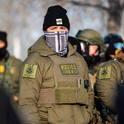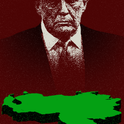More than two months have passed since George Floyd died under the knee of an American police officer in Minneapolis. As Floyd lost his breath, he cried out “I can’t breathe,” words that have become a rallying cry for many protesting against systemic racism and police brutality.
The protests have resonated in public art throughout the US. Close to Cup Foods, where the killing took place, three artists created a large mural in Floyd’s honour, above. His name is embodied by the protesting masses, while other victims of racist killings are depicted as seeds unable to grow into a sunflower, the centre of which forms a black halo round Floyd. The mural now serves as a symbolic memorial where people offer candles, flowers, and other gifts.
Protests, vigils and visual commemorations in honour of Floyd have since spread across the world—in Europe of course, but also in Middle Eastern countries. The pictorial responses in Iran, Syria, and Afghanistan are most noteworthy because they reveal how his killing has touched a nerve among communities beyond the US.
The Iranian artist Mehdi “Amo” Rasooli, who is well known for his scathing critiques of America, produced a cartoon entitled American Debris that shows President Donald Trump sweeping the remains of human beings under the American flag.
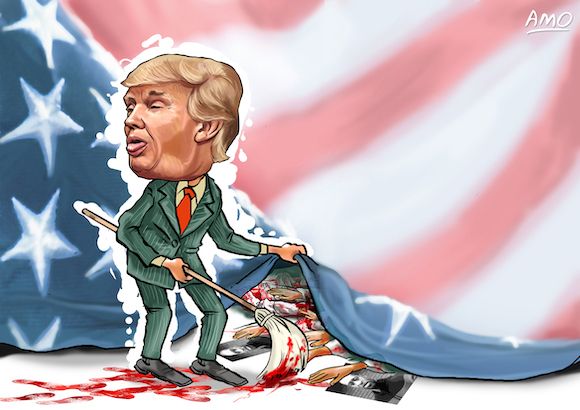
Scattered among severed hands and bloodied bodies are black-and-white photographs of Floyd. Moreover, another Iranian artist produced a cartoon in which the American flag’s red stripes are drawn in blood red by the body of a deceased African-American dragged away by police officers (below).
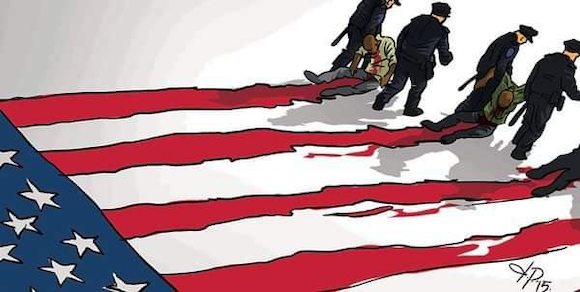
These type of visuals stretch back to the Iranian Revolution of 1979. Many state-sponsored murals depict the US flag as though it were an instrument of death and destruction. Among them, one 15-storey mural in Tehran shows the US flag with stars transformed into skulls and red stripes turning into missiles. The slogan “Down with the USA,” as painted on the mural, transfers over to the more recent cartoon. In both cases, the anti-American thrust of the protesting images falls in line with the Iranian government’s official narrative about the “Great Satan.”
But Floyd’s killing has not only provided fuel to fire anti-American sentiment. Instead, his death has activated other responses, including empathy and solidarity. In Syria, for instance, the artists Aziz Asmar and Anis Hamdun painted a mural in Binnish, a city in the Idlib province. The mural depicts Floyd in light rose, grey and blue hues, exclaiming “No to racism” and “I can’t breathe.”
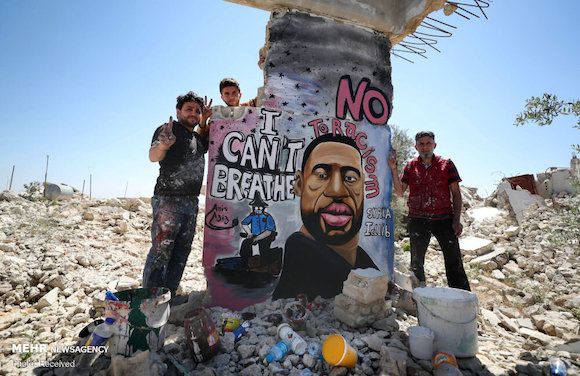
Idlib is located between Aleppo and Homs in northwest Syria, close to the Turkish border. It has been controlled by opposition forces ever since the 2011 Arab Spring protests. Unfortunately, much of the area has been destroyed by those loyal to the Assad regime. The only surviving wall of a bombed out building provides the cement backdrop for the Floyd mural.
Aziz Asmar, one of the muralists, has said that George Floyd’s killing serves as a metaphor for the death and breathlessness of the Syrian people, especially during the chemical attacks on rebel strongholds. “In those hospitals, the victims were crying, and they were asking to breathe. I saw George Floyd pleading with the officer to let him breathe, and it reminded me of the way they were killed.” Aziz Asmar continues: “We’re trying to show that despite being bombed and losing people, and then being called terrorists, we still feel empathy. We still feel for people like George Floyd, who are being oppressed in other parts of the world.”
In Syria, artists such as Aziz Asmar and others are not using the death of George Floyd to take an antagonistic stance toward the US. This tragic event instead has inspired them to express camaraderie with individuals who are oppressed, or disenfranchised in various ways. The mural serves, above all, to lambast the Assad regime—and not an outside polity such as the United States.
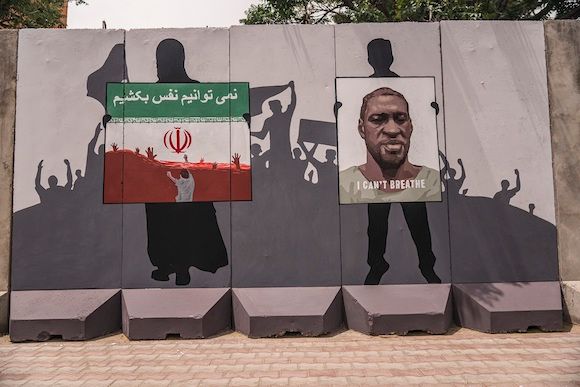
Another mural went up recently in Kabul, Afghanistan, above. It appears on a cement blast wall that was erected by American forces in order to protect a high security zone (called the “Green Zone”), where many foreign embassies are now located. This mural is situated close to the Iranian embassy, a location that bears larger political significance. Made by Afghan artist Mihr Agha Sultani, the composition outlines in grey tones the presence of protestors in the background, one of whom, a man, holds up an image of Floyd along with the slogan “I can’t breathe.” Next to him stands the silhouette of a veiled woman who also carries a poster.
This is the more intriguing section of the mural: it represents not the US flag but the Iranian one. Here the red turns into a sea of blood, with outstretched hands suggesting people trying to save themselves from drowning. The Iranian flag’s upper green part is filled with a Persian expression that reads “We can't breathe.” Here then, an Afghan artist is pictorially denouncing Iran. But why, and how does this relate to Floyd?
A few recent incidents in Iran help shed light on the matter. On 5th June, a number of Afghan refugees died in a car when police shot at it, turning it into a firebomb. A young boy managed to run out, his skin turned ashen by flames, screaming: “Give me some water, I’m burning!” This horrifying episode was captured on video and went viral on Twitter. Moreover, on 1st May, Afghan migrants crossed the Iranian-Afghan border at the Hari River. After they were caught, it appears that they were tortured and drowned by Iranian border guards.
These and other incidents have been used as a rallying cry for the rights of the three million Afghan refugees in Iran. These individuals comprise an underclass that has suffered from discrimination and hence see themselves as walking in the shoes of Floyd. Many of the visuals and hashtags equate the slogans “I can’t breathe” with “I am burning,” reiterating that we are all human—both Afghan and black lives matter.
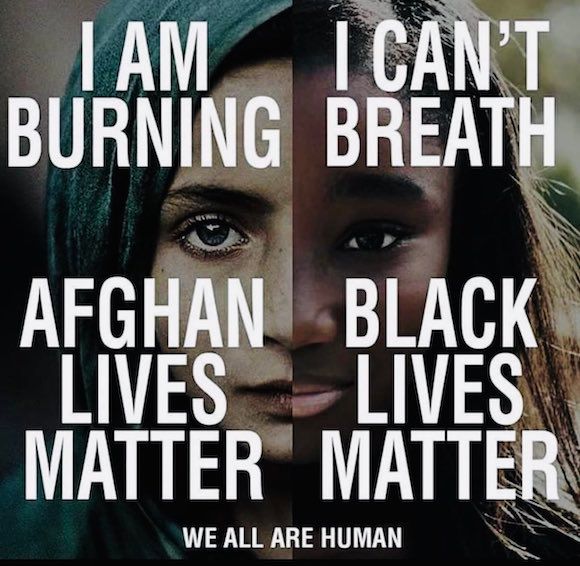
Although he perished in specific circumstances, George Floyd has become the embodiment of deadly discrimination in Islamic countries. Whether in Iran, Syria, or Afghanistan, different messages have been tethered to this American “martyr.” These range from trenchant critiques of the United States’ government to a call for human solidarity and an end to racism for citizens and immigrants worldwide.


